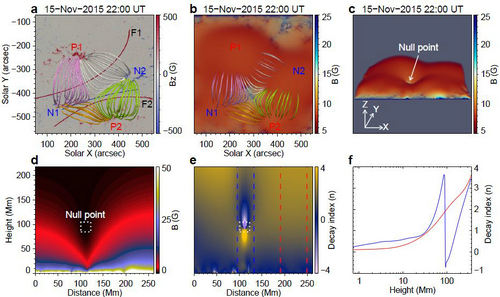Chinese solar physicists reveal the complete physical scenario of the sympathetic eruption of two solar filaments
Solar filaments are large magnetic structures confining cool and dense plasma suspended in the hot and tenuous corona. Studies about the filament eruptions are important in deepening the understanding for solar eruptions and in forecasting disastrous space weather.
In the classical solar eruption model, filament eruptions, solar flares, and coronal mass ejections (CMEs) are different observational manifestations of a more general single eruption process. The Sun also ubiquitously breeds sympathetic eruptions, which are defined as causally linked eruptions occurring with a relatively short time interval in different, but physically related source regions. Recent observational and numerical works suggest that the physical linkages between the sympathetic eruptions should essentially be of a magnetic nature. However, the exact physical mechanism of the sympathetic eruptions of two filaments is still not well understood.
Recently, Dr. Yijun Hou from National Astronomical Observatories of Chinese Academy of Sciences (NAOC), together with other collaborators, study a sympathetic event (Figure 1) involving successive eruptions of two filaments (F1 and F2) and reveal a complete physical scenario of the sympathetic eruption. The relevant results have been reported in two papers, which are published in Astronomy & Astrophysics on 21 August 2020 and The Astrophysical Journal on 31 March 2020, respectively.
From the aspects of pre-existing magnetic topology in favor of reconnection, observational evidence of the external reconnection, and the reconnection-related reconfiguration of overlying fields, the researchers propose an integrated evidence chain to demonstrate the critical roles of external magnetic reconnection and the resultant reconfiguration of overlying fields on the sympathetic eruptions of two filaments.
“Our observations show that after F1 first erupted due to the magnetic flux cancellation, an inward-spreading brightening and a dimming region were observed to the south of stable F2. The fields above pre-eruption F1 and F2 constituted a quadrupolar magnetic system with a possible null point (Figure 2), and the null point kept moving toward F2 and descending,” Dr. Yijun Hou said.
“These results indicate that the rising F1 pushed its overlying fields toward the fields above stable F2 and caused successive external reconnection between the overlying fields. From outside to inside (lower and lower in height), the fields above pre-eruption F2 were gradually involved in the reconnection, manifesting as the inward-spreading brightening and extending dimming on the south side of F2. Furthermore, the external reconnection could reconfigure the overlying fields of F2 by transporting magnetic flux from its west part to the east part, which is further verified by the subsequent partial eruption of F2,” he said.
The coupling among multiple spatio-temporal solar activities is a basic problem in solar physics, which is closely related to the magnetic field of solar atmosphere and various solar eruptions. The results revealed in the two research papers further complement the study of sympathetic eruptions of two solar filaments, as well as the relation between filament eruptions and large-scale coronal fields, and hence help us forecast disastrous space weather.

Figure 1: Overview of the sympathetic eruptions of two filaments and subsequent flares and CMEs. (Credit: Yijun Hou)

Figure 2: Three-dimensional (3D) magnetic fields above F1 and F2 revealed by NLFFF extrapolation before the eruption. (Credit: Yijun Hou)
The two related papers can be accessed, respectively, at the following links:
1. https://www.aanda.org/articles/aa/full_html/2020/08/aa38348-20/aa38348-20.html
2. https://iopscience.iop.org/article/10.3847/1538-4357/ab77b3